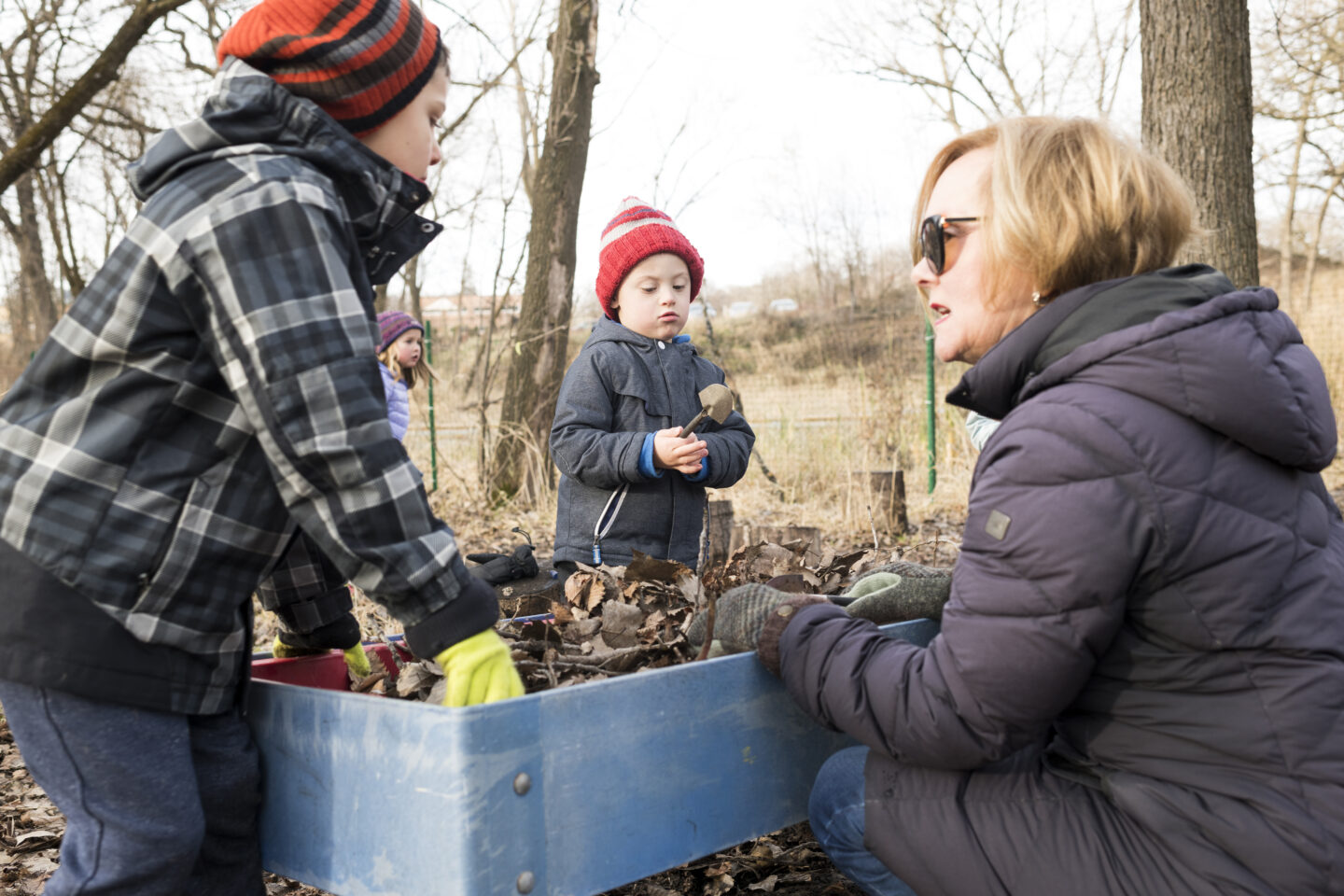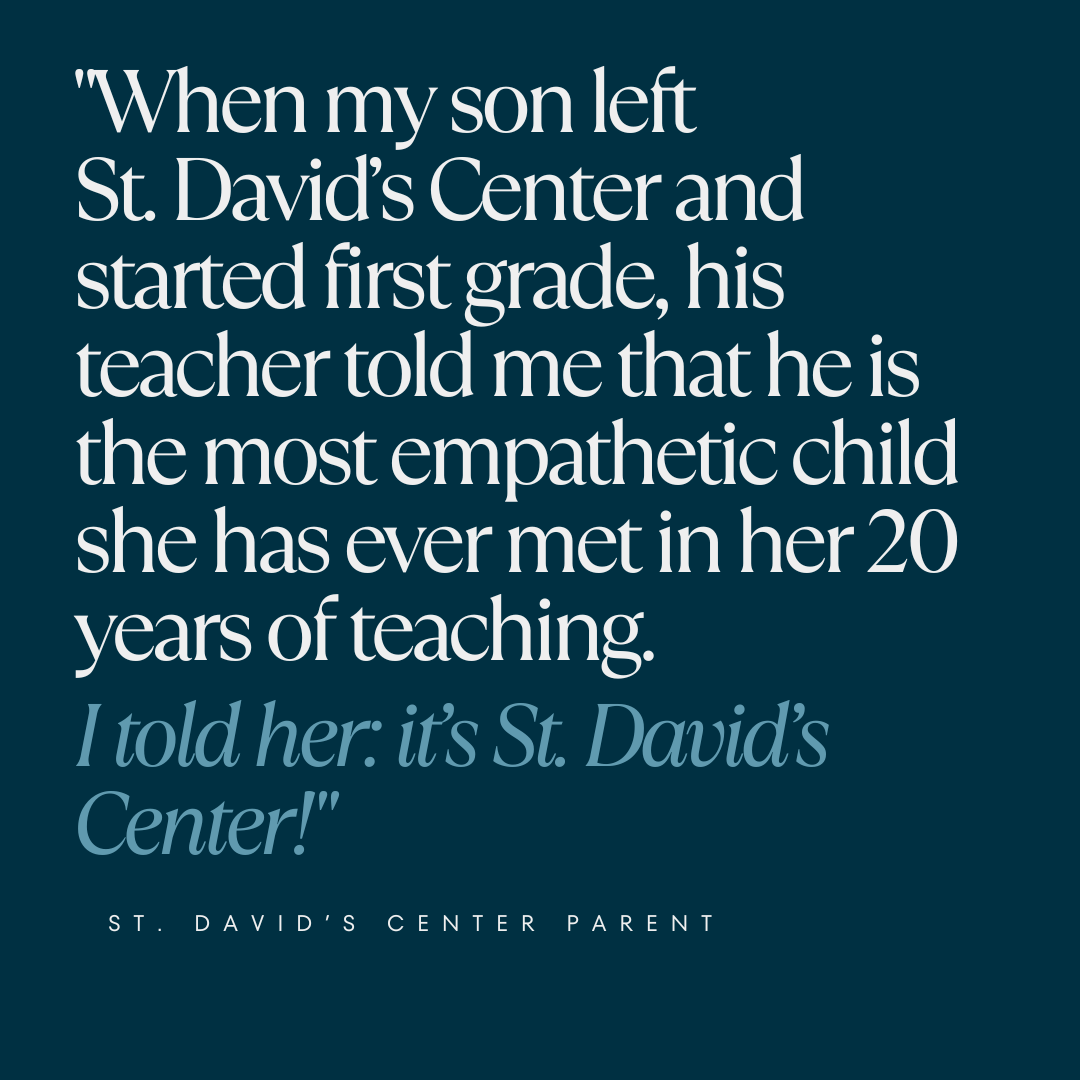Growing Together: Inclusive Outdoor Early Childhood Education


 St. David’s Center’s Early Childhood Education Program is unique. Our approach to the foundational learning years is inclusive, individualized, and deeply rooted in nature, for toddlers, through pre-kindergarten. That means that children with typical development learn right alongside children with developmental delays and disabilities, and much of our learning happens outside, rain or shine! The benefits of inclusive classrooms are well-documented for children with complex needs, and in fact, researchers around the world agree that inclusive learning helps all children excel. Because so few early childhood education programs offer deeply inclusive learning in the comprehensive way that St. David’s Center’s does, those benefits are rare. Combine that with the documented benefits of outdoor education and low student-to-teacher ratios, and you have a perfect environment for growth. This is certainly the case at St. David’s Center, where we create opportunities for all children to absorb the emotional and cognitive benefits of the great outdoors. Our center is located on ten acres of land that include a DNR-certified school forest, two outdoor classrooms, and two playgrounds.
St. David’s Center’s Early Childhood Education Program is unique. Our approach to the foundational learning years is inclusive, individualized, and deeply rooted in nature, for toddlers, through pre-kindergarten. That means that children with typical development learn right alongside children with developmental delays and disabilities, and much of our learning happens outside, rain or shine! The benefits of inclusive classrooms are well-documented for children with complex needs, and in fact, researchers around the world agree that inclusive learning helps all children excel. Because so few early childhood education programs offer deeply inclusive learning in the comprehensive way that St. David’s Center’s does, those benefits are rare. Combine that with the documented benefits of outdoor education and low student-to-teacher ratios, and you have a perfect environment for growth. This is certainly the case at St. David’s Center, where we create opportunities for all children to absorb the emotional and cognitive benefits of the great outdoors. Our center is located on ten acres of land that include a DNR-certified school forest, two outdoor classrooms, and two playgrounds.
So, what are some of the benefits of inclusive classrooms for students with typical development? We talked with parents, teachers, care coordinators, and support staff here at St. David’s Center, and consulted research from the US, Canada, Europe, United Kingdom, and Australia. We were pleased with what we learned!
All children grow socially & emotionally in inclusive classrooms with low student-to teacher ratios.
A review of research worldwide reveals the positive social and emotional impact for students with typical development in inclusive classrooms. These children exhibit an increased acceptance of difference, more effective communication with all peers, increased self-esteem and sense of belonging, personal moral and ethical development, and uniquely warm and caring friendships. With a low student-to-teacher ratios like those at St. David’s Center, the social and emotional benefits are even greater as educators can nurture social skills and respond to emotional needs in the classroom as they emerge. This kind of attention allows children to build strong relationships with peers and adults, and to adopt positive social behaviors – like politeness, kindness, and respect — that will serve them for the rest of their lives. In inclusive, intimate classrooms like these, children show a heightened ability to help, share, cooperate, comfort, and show concern for others, beyond what is typically observed in their peers.
Individualized teaching nurtures a love of learning & helps children get school ready
Studies show that children’s academic performance excels when they learn alongside students with developmental delays and disabilities. That’s because teachers develop innovative
teaching strategies that are responsive to all types of learners, typical and atypical alike. With low student-to-teacher ratios, these benefits are especially great as students receive increased instruction and one-on-one support. When teachers have the flexibility and skills to tailor lessons for each child, intellectual development flourishes. For young learners this includes things like: language development, foundational literacy and mathematics skills, motor development, executive functions, as well as approaches to learning like a growth mindset and motivation.
Inclusive and diverse classrooms prepare students for a diverse world.
Classrooms that are inclusive of students with non-typical development and with disabilities are classrooms that deeply manifest all kinds of inclusivity. The benefits of diverse classrooms have been widely documented, and those benefits only grow with classrooms that are inclusive in terms of development and ability. These benefits include improved cognitive and critical thinking skills as students are encouraged to consider different viewpoints, fostering creativity, as well as problem-solving and decision-making skills. Inclusive and diverse classrooms also foster increased civic engagement for students over their lives. And they help to build broad cultural understanding, and a deep appreciation and respect for differences of all kinds.
As one St. David’s Center team member said “I see it every day. Typically developing children absolutely benefit just as much as their friends with special needs. The rewards are all around.” And St. David’s Center’s Early Childhood Education program lets children be the drivers of positive change, too, with their “Buddy System,” which allows children with typical development to connect deeply with children with developmental delays and disabilities. This gives both “buddies” the chance to learn from, and support, one another. We know children who build their love of learning at St. David’s Center will not only be ready for kindergarten but will be ready to lead with compassion and thrive in a complex and diverse world.
Works Cited
European Agency for Special Needs and Inclusive Education. (2018). Evidence of the link between inclusive education and social inclusion: A review of the literature (S. Symeonidou, Ed.). Odense, Denmark.
Hehir, T., Grindal, T., Freeman, B., Lamoreau, R., Borquaye, Y., & Alana, S. (2016). A summary of the evidence on inclusive education. Abt Associates. Retrieved from http://alana.org.br/en/
Kasari, C., Shire, S., Shih, W., & Almirall, D. (2021). Getting SMART about social skills interventions for students with ASD in inclusive classrooms. Exceptional Children, 88(1), 26-44. https://doi.org/10.1177/00144029211007148
Laushey, K. M., & Hefin, L. J. (2000). Enhancing social skills of kindergarten children with autism through the training of multiple peers as tutors. Journal of Autism and Developmental Disorders, 30(3), 183-193.
Leijen, Ä., Arcidiacono, F., & Baucal, A. (2021). The dilemma of inclusive education: Inclusion for some or inclusion for all? Frontiers in Psychology, 12, Article 633066. https://doi.org/10.3389/fpsyg.2021.633066